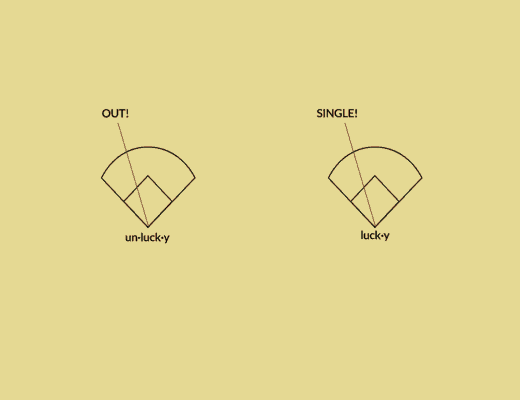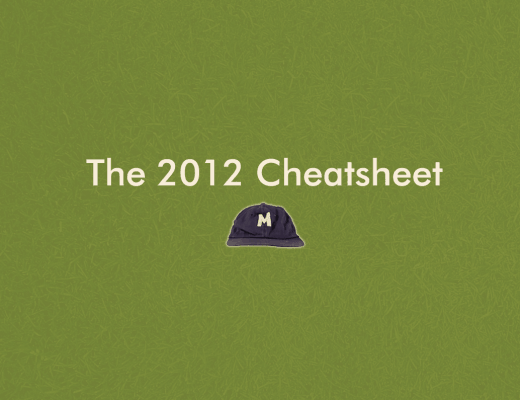Having the fanciest, most advanced cheatsheet to use in your draft can be extremely handy but sometimes simplicity is what you are after. In those cases, having a nice printable one-sheet page with the most basic info should be all you’ll ever need on draft day.
Below you’ll find links to four variations of a simple PDF cheatsheet. Within the cheatsheet, you’ll see players broken down by position and ordered by their average draft position (ADP) at each site but they are then broken into tiers at that position based on where there are projected drops in value at that position. You’ll quickly get a glance at where the value lies at each position and who you might want to target before a tier is all used up.
You can also gauge each player’s value within that tier as I put each player’s projected WERTH value (based on my Special Blend projections) next to their name. These are new position-adjusted WERTH values which account for position scarcity with a value of zero representing a replacement level player at that position and anything below zero representing a projected bench player or a starter who will deliver negative value. You may notice that a player who is eligible at multiple positions may have very different values at each position as a result of the position adjustment.
2014 Average ADP Tiered Cheatsheet
2014 CBS Leagues ADP Tiered Cheatsheet
2014 ESPN Leagues ADP Tiered Cheatsheet
2014 Yahoo Leagues ADP Tiered Cheatsheet
How To Use
You have a few ways to utilize these cheatsheets during your draft. Of course, you could print these out and cross off names with a pen or pencil during the draft but that may be too old school for you. If so, you can always use a PDF editor to cross off names as they get drafted during your draft.

To accomplish this, I recommend using PDF-XChange Viewer which is a free alternative to Adobe Acrobat (which you could also use). If you do, you can use the Cross Out Text tool under Comment & Markup Tools. It’s a nice way to still have your computer in front of you (and hide your cheatsheet) but keep up to date about who is available at each position.
Oh, and if you’re looking for something a bit more adventurous, you still could always download my massively customizable Excel cheatsheets.




Joshua Cameron
03/10/2014 at 2:44 AMJust wanted to thank you, as I think these are great! I did notice however that these are for 5×5 roto. Anyway you can make available similar sheet for HTH points based leagues?
Thanks again!
Kent Hinterman
03/10/2014 at 1:56 PMI would love to use this, but I am in a 17 team league… back to the excel!
Luke
03/10/2014 at 1:59 PMI was actually thinking of doing that… Gotta find what a good default scoring system to use would be for a basic H2H sheet though. I'll see what I can do.
Luke
03/10/2014 at 2:00 PMAh man, yeah! I could come up with many versions but 17 teamer is pretty unique. No promises but I'm going to try to add in a new page to the Excel sheets that would do a similar tiered positional list… We'll see if I can get it done in time for drafts though!
Ben Gellman-Chomsky
03/10/2014 at 7:24 PMReposted here in hopes you'll see it and answer:
In terms of placing proper value on pitching rate stats in my league (K/9, K/BB, ERA, WHIP, BAA), I’m trying to weight my Z-values for those by innings pitched, so that somebody with more IP gets more credit to reflect that rate stat being used across a greater number of innings. When using Steamer projections, my formula for this has been to multiply the initial Z-value by (Individual IP/201), since 201 was the maximum IP in the Steamer projections (Wainwright). For example, a pitcher with a K/9 of 9.0 in 175 innings would be treated as though he had only a 7.835 K/9. (My league has 11 pitching stats: IP, W, ERA, SO, SV, HD, QS, BAA, WHIP, K/9, K/BB.)
However, when I do this, top relievers like Kimbrel/Chapman/Jansen take massive hits in value; Kimbrel goes from being valued among the top 10 pitchers to being behind the likes of Hyun-Jin Ryu, Ian Kennedy and Matt Garza, while Jansen slips behind Scott Kazmir. I feel like this is too big a drop, but I’m not sure how to mitigate this without overbalancing. Am I twisting data to suit my conclusions, or am I right to think Kimbrel is better than Ryu/Garza?
Luke
03/10/2014 at 7:36 PMI actually had planned to address this in an upcoming article. You've got the right idea of weighting innings for your rate stats but it's a little different than that. For my league-based roto values, I calculate ERA z-scores by evaluating the change in a fantasy team's ERA that would occur by owning that player versus a league average player. So, the formula ends up being:
((((IP/Total Team IP) * ERA) + ((1 – (IP/Total Team IP)) * League ERA)) – League ERA
Total Team IP would be the projected total IP for an average team in that league format. For example, a 5 SP, 2 RP, 1 P 12-team league might average 1250 IP per team.
So for Kershaw, for example, the calculation would be ((((222 / 1250) * 3.09) + ((1 – (222/ 1250) * 3.3885)) – 3.3885
So, Kershaw's projected 3.09 ERA would account for 17.76% of the contribution to his roto team's ERA. And if we assume the other 82.24% of his team's ERA is league average (3.3885) then having Kershaw on a team of otherwise league average pitchers decreases their team ERA by 0.053.
((0.548784) + (2.7867)) – 3.3885 = (-0.053)
So then I use that Change in ERA for each player and calculate the z-scores there to determine the pitcher's ERA contribution. I do the same thing for WHIP, etc.
Randy Munro
03/11/2014 at 12:30 AMYa that would be fantastic! It can be so hard to find stuff on H2H points.
Any tips on finding quality H2H points articles?
Luke
03/11/2014 at 12:55 AMI hear ya. A majority of my leagues are actually point leagues. Here's an article I wrote last year that I plan on revisiting this year: http://www.mrcheatsheet.com/2013/03/hidden-value-in-point-based-leagues-key.html
Kent Hinterman
03/13/2014 at 3:59 PMThanks Luke. Love the work put into this